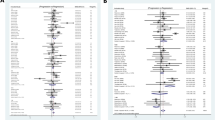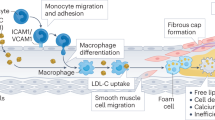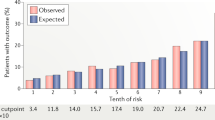Abstract
Lowering low-density lipoprotein cholesterol is the cornerstone of risk modification in patients with established coronary artery disease. Considerable attention is currently focused on developing pharmacologic agents that promote the biologic activity of high-density lipoprotein. Advances in imaging of the artery wall provide the opportunity to evaluate the impact of medical therapies on serial changes in plaque burden. A number of reports describe the favorable effects of interventions that lower low-density lipoprotein cholesterol or promote the biologic activity of high-density lipoprotein. The current state of evidence defining the relative contribution of changes in plasma lipids on the tendency to plaque regression is reviewed.
Similar content being viewed by others
References and Recommended Reading
Stamler J, Wentworth D, Neaton JD: Is relationship between serum cholesterol and risk of premature death from coronary heart disease continuous and graded? Findings in 356,222 primary screenees of the Multiple Risk Factor Intervention Trial (MRFIT). JAMA 1986, 256:2823–2828.
Finking G, Hanke H: Nikolaj Nikolajewitsch Anitschkow (1885–1964) established the cholesterol-fed rabbit as a model for atherosclerosis research. Atherosclerosis 1997, 135:1–7.
Aikawa M, Rabkin E, Okada Y, et al.: Lipid lowering by diet reduces matrix metalloproteinase activity and increases collagen content of rabbit atheroma: a potential mechanism of lesion stabilization. Circulation 1998, 97:2433–2444.
Randomised trial of cholesterol lowering in 4444 patients with coronary heart disease: the Scandinavian Simvastatin Survival Study (4S). Lancet 1994, 344:1383–1389.
Prevention of cardiovascular events and death with pravastatin in patients with coronary heart disease and a broad range of initial cholesterol levels. The Long-Term Intervention with Pravastatin in Ischaemic Disease (LIPID) Study Group. N Engl J Med 1998, 339:1349–1357.
MRC/BHF Heart Protection Study of cholesterol lowering with simvastatin in 20,536 high-risk individuals: a randomised placebo-controlled trial. Lancet 2002, 360:7–22.
Downs JR, Clearfield M, Weis S, et al.: Primary prevention of acute coronary events with lovastatin in men and women with average cholesterol levels: results of AFcaps/Texcaps. AirForce/Texas Coronary Atherosclerosis Prevention Study. JAMA 1998, 279:1615–1622.
Sacks FM, Pfeffer MA, Moye LA, et al.: The effect of pravastatin on coronary events after myocardial infarction in patients with average cholesterol levels. Cholesterol and Recurrent Events Trial investigators. N Engl J Med 1996, 335:1001–1009.
Shepherd J, Cobbe SM, Ford I, et al.: Prevention of coronary heart disease with pravastatin in men with hypercholesterolemia. West of Scotland Coronary Prevention Study Group. N Engl J Med 1995, 333:1301–1307.
Cannon CP, Braunwald E, McCabe CH, et al.: Intensive versus moderate lipid lowering with statins after acute coronary syndromes. N Engl J Med 2004, 350:1495–1504.
LaRosa JC, Grundy SM, Waters DD, et al.: Intensive lipid lowering with atorvastatin in patients with stable coronary disease. N Engl J Med 2005, 352:1425–1435.
Pedersen TR, Faergeman O, Kastelein JJ, et al.: High-dose atorvastatin vs usual-dose simvastatin for secondary prevention after myocardial infarction: the IDEAL study: a randomized controlled trial. JAMA 2005, 294:2437–2445.
Baigent C, Keech A, Kearney PM, et al.: Efficacy and safety of cholesterol-lowering treatment: prospective meta-analysis of data from 90,056 participants in 14 randomised trials of statins. Lancet 2005, 366:1267–1278.
Takemoto M, Liao JK: Pleiotropic effects of 3-hydroxy-3-methylglutaryl coenzyme a reductase inhibitors. Arterioscler Thromb Vasc Biol 2001, 21:1712–1719.
Stenestrand U, Wallentin L: Early statin treatment following acute myocardial infarction and 1-year survival. JAMA 2001, 285:430–436.
Schwartz GG, Olsson AG, Ezekowitz MD, et al.: Effects of atorvastatin on early recurrent ischemic events in acute coronary syndromes: the MIRACL study: a randomized controlled trial. JAMA 2001, 285:1711–1718.
Gordon T, Castelli WP, Hjortland MC, et al.: High density lipoprotein as a protective factor against coronary heart disease. The Framingham Study. Am J Med 1977, 62:707–714.
Badimon JJ, Badimon L, Fuster V: Regression of atherosclerotic lesions by high density lipoprotein plasma fraction in the cholesterol-fed rabbit. J Clin Invest 1990, 85:1234–1241.
Nicholls SJ, Cutri B, Worthley SG, et al.: Impact of short-term administration of high-density lipoproteins and atorvastatin on atherosclerosis in rabbits. Arterioscler Thromb Vasc Biol 2005, 25:2416–2421.
Barter PJ, Nicholls S, Rye KA, et al.: Antiinflammatory properties of HDL. Circ Res 2004, 95:764–772.
Brewer HB Jr: Increasing HDL cholesterol levels. N Engl J Med 2004, 350:1491–1494.
Nissen SE, Nicholls SJ, Sipahi I, et al.: Effect of very high-intensity statin therapy on regression of coronary atherosclerosis: the ASTEROID trial. JAMA 2006, 295:1556–1565.
Nissen SE, Tsunoda T, Tuzcu EM, et al.: Effect of recombinant ApoA-I Milano on coronary atherosclerosis in patients with acute coronary syndromes: a randomized controlled trial. JAMA 2003, 290:2292–2300.
Okazaki S, Yokoyama T, Miyauchi K, et al.: Early statin treatment in patients with acute coronary syndrome: demonstration of the beneficial effect on atherosclerotic lesions by serial volumetric intravascular ultrasound analysis during half a year after coronary event: the ESTABLISH Study. Circulation 2004, 110:1061–1068.
Jensen LO, Thayssen P, Pedersen KE, et al.: Regression of coronary atherosclerosis by simvastatin: a serial intravascular ultrasound study. Circulation 2004, 110:265–270.
Chambless LE, Heiss G, Folsom AR, et al.: Association of coronary heart disease incidence with carotid arterial wall thickness and major risk factors: the Atherosclerosis Risk in Communities (ARIC) Study, 1987–1993. Am J Epidemiol 1997, 146:483–494.
Lorenz MW, Markus HS, Bots ML, et al.: Prediction of clinical cardiovascular events with carotid intima-media thickness: a systematic review and meta-analysis. Circulation 2007, 115:459–467.
Glagov S, Weisenberg E, Zarins CK, et al.: Compensatory enlargement of human atherosclerotic coronary arteries. N Engl J Med 1987, 316:1371–1375.
Mintz GS, Painter JA, Pichard AD, et al.: Atherosclerosis in angiographically “normal” coronary artery reference segments: an intravascular ultrasound study with clinical correlations. J Am Coll Cardiol 1995, 25:1479–1485.
Schoenhagen P, Ziada KM, Vince DG, et al.: Arterial remodeling and coronary artery disease: the concept of “dilated” versus “obstructive” coronary atherosclerosis. J Am Coll Cardiol 2001, 38:297–306.
Schoenhagen P, Tuzcu EM, Ellis SG: Plaque vulnerability, plaque rupture, and acute coronary syndromes: (multi)-focal manifestation of a systemic disease process. Circulation 2002, 106:760–762.
Mintz GS, Kent KM, Pichard AD, et al.: Intravascular ultrasound insights into mechanisms of stenosis formation and restenosis. Cardiol Clin 1997, 15:17–29.
Kapadia SR, Nissen SE, Tuzcu EM: Impact of intravascular ultrasound in understanding transplant coronary artery disease. Curr Opin Cardiol 1999, 14:140–150.
Greenland P, LaBree L, Azen SP, et al.: Coronary artery calcium score combined with Framingham score for risk prediction in asymptomatic individuals. JAMA 2004, 291:210–215.
Pletcher MJ, Tice JA, Pignone M, Browner WS: Using the coronary artery calcium score to predict coronary heart disease events: a systematic review and meta-analysis. Arch Intern Med 2004, 164:1285–1292.
Achenbach S, Ropers D, Pohle FK, et al.: Detection of coronary artery stenoses using multi-detector CT with 16x0.75 collimation and 375 ms rotation. Eur Heart J 2005, 26:1978–1986.
Salm LP, Bax JJ, Jukema JW, et al.: Comprehensive assessment of patients after coronary artery bypass grafting by 16-detector-row computed tomography. Am Heart J 2005, 150:775–781.
Fayad ZA, Nahar T, Fallon JT, et al.: In vivo magnetic resonance evaluation of atherosclerotic plaques in the human thoracic aorta: a comparison with transesophageal echocardiography. Circulation 2000, 101:2503–2509.
Kang S, Wu Y, Li X: Effects of statin therapy on the progression of carotid atherosclerosis: a systematic review and meta-analysis. Atherosclerosis 2004, 177:433–442.
Smilde TJ, van Wissen S, Wollersheim H, et al.: Effect of aggressive versus conventional lipid lowering on atherosclerosis progression in familial hypercholesterolaemia (ASAP): a prospective, randomised, double-blind trial. Lancet 2001, 357:577–581.
Taylor AJ, Kent SM, Flaherty PJ, et al.: ARBITER: Arterial Biology for the Investigation of the Treatment Effects of Reducing Cholesterol: a randomized trial comparing the effects of atorvastatin and pravastatin on carotid intima medial thickness. Circulation 2002, 106:2055–2060.
Crouse JR 3rd, Grobbee DE, O’Leary DH, et al.: Measuring Effects on intima media Thickness: an Evaluation Of Rosuvastatin in subclinical atherosclerosis—the rationale and methodology of the METEOR study. Cardiovasc Drugs Ther 2004, 18:231–238.
Kastelein JJ, Sager PT, de Groot E, Veltri E: Comparison of ezetimibe plus simvastatin versus simvastatin monotherapy on atherosclerosis progression in familial hypercholesterolemia. Design and rationale of the Ezetimibe and Simvastatin in Hypercholesterolemia Enhances Atherosclerosis Regression (ENHANCE) trial. Am Heart J 2005, 149:234–239.
Buchwald H, Varco RL, Matts JP, et al.: Effect of partial ileal bypass surgery on mortality and morbidity from coronary heart disease in patients with hypercholesterolemia. Report of the Program on the Surgical Control of the Hyperlipidemias (POSCH). N Engl J Med 1990, 323:946–955.
Koga N, Iwata Y: Pathological and angiographic regression of coronary atherosclerosis by LDL-apheresis in a patient with familial hypercholesterolemia. Atherosclerosis 1991, 90:9–21.
Kitabatake A, Sato H, Hori M, et al.: Coronary atherosclerosis reduced in patients with familial hypercholesterolemia after intensive cholesterol lowering with low-density lipoprotein-apheresis: 1-year follow-up study. The Osaka LDL-Apheresis Multicenter Trial Group. Clin Ther 1994, 16:416–428.
Thompson GR, Maher VM, Matthews S, et al.: Familial Hypercholesterolaemia Regression Study: a randomised trial of low-density-lipoprotein apheresis. Lancet 1995, 345:811–816.
Kroon AA, Aengevaeren WR, van der Werf T, et al.: LDL-Apheresis Atherosclerosis Regression Study (LAARS). Effect of aggressive versus conventional lipid lowering treatment on coronary atherosclerosis. Circulation 1996, 93:1826–1835.
Ballantyne CM: Clinical trial endpoints: angiograms, events, and plaque instability. Am J Cardiol 1998, 82:5M–11M.
Nissen SE, Tuzcu EM, Schoenhagen P, et al.: Effect of intensive compared with moderate lipid-lowering therapy on progression of coronary atherosclerosis: a randomized controlled trial. JAMA 2004, 291:1071–1080.
Nissen SE, Tuzcu EM, Schoenhagen P, et al.: Statin therapy, LDL cholesterol, C-reactive protein, and coronary artery disease. N Engl J Med 2005, 352:29–38.
Matsuzaki M, Hiramori K, Imaizumi T, et al.: Intravascular ultrasound evaluation of coronary plaque regression by low density lipoprotein-apheresis in familial hypercholesterolemia: the Low Density Lipoprotein-Apheresis Coronary Morphology and Reserve Trial (LACMART). J Am Coll Cardiol 2002, 40:220–227.
Achenbach S, Ropers D, Pohle K, et al.: Influence of lipidlowering therapy on the progression of coronary artery calcification: a prospective evaluation. Circulation 2002, 106:1077–1082.
Raggi P, Davidson M, Callister TQ, et al.: Aggressive versus moderate lipid-lowering therapy in hypercholesterolemic postmenopausal women: Beyond Endorsed Lipid Lowering with EBT Scanning (BELLES). Circulation 2005, 112:563–571.
Schmermund A, Achenbach S, Budde T, et al.: Effect of intensive versus standard lipid-lowering treatment with atorvastatin on the progression of calcified coronary atherosclerosis over 12 months: a multicenter, randomized, double-blind trial. Circulation 2006, 113:427–437.
Nicholls SJ, Tuzcu EM, Wolski K, et al.: Coronary artery calcification and changes in atheroma burden in response to established medical therapies. J Am Coll Cardiol 2007, 49:263–270.
Corti R, Fayad ZA, Fuster V, et al.: Effects of lipid-lowering by simvastatin on human atherosclerotic lesions: a longitudinal study by high-resolution, noninvasive magnetic resonance imaging. Circulation 2001, 104:249–252.
Nicholls SJ, Tuzcu EM, Sipahi I, et al.: Relationship between atheroma regression and change in lumen size after infusion of apolipoprotein A-I Milano. J Am Coll Cardiol 2006, 47:992–997.
Corti R, Fuster V, Fayad ZA, et al.: Lipid lowering by simvastatin induces regression of human atherosclerotic lesions: two years’ follow-up by high-resolution noninvasive magnetic resonance imaging. Circulation 2002, 106:2884–2887.
Corti R, Fuster V, Fayad ZA, et al.: Effects of aggressive versus conventional lipid-lowering therapy by simvastatin on human atherosclerotic lesions: a prospective, randomized, double-blind trial with high-resolution magnetic resonance imaging. J Am Coll Cardiol 2005, 46:106–112.
Hatsukami T, Zhao XQ, Krauss LW: Assessment of rosuvastatin treatment on carotid atherosclerosis in moderately hypercholesterolemic subjects using high-resolution magnetic resonance imaging. Eur Heart J 2005, 26:626.
Taylor AJ, Sullenberger LE, Lee HJ, et al.: Arterial Biology for the Investigation of the Treatment Effects of Reducing Cholesterol (ARBITER) 2: a double-blind, placebo-controlled study of extended-release niacin on atherosclerosis progression in secondary prevention patients treated with statins. Circulation 2004, 110:3512–3517.
Taylor AJ, Lee HJ, Sullenberger LE: The effect of 24 months of combination statin and extended-release niacin on carotid intima-media thickness: ARBITER 3. Curr Med Res Opin 2006, 22:2243–2250.
Brown BG, Zhao XQ, Chait A, et al.: Simvastatin and niacin, antioxidant vitamins, or the combination for the prevention of coronary disease. N Engl J Med 2001, 345:1583–1592.
Ericsson CG, Hamsten A, Nilsson J, et al.: Angiographic assessment of effects of bezafibrate on progression of coronary artery disease in young male postinfarction patients. Lancet 1996, 347:849–853.
Ericsson CG, Nilsson J, Grip L, et al.: Effect of bezafibrate treatment over five years on coronary plaques causing 20% to 50% diameter narrowing (The Bezafibrate Coronary Atherosclerosis Intervention Trial [BECAIT]). Am J Cardiol 1997, 80:1125–1129.
Ruotolo G, Ericsson CG, Tettamanti C, et al.: Treatment effects on serum lipoprotein lipids, apolipoproteins and low density lipoprotein particle size and relationships of lipoprotein variables to progression of coronary artery disease in the Bezafibrate Coronary Atherosclerosis Intervention Trial (BECAIT). J Am Coll Cardiol 1998, 32:1648–1656.
Effect of fenofibrate on progression of coronary-artery disease in type 2 diabetes: the Diabetes Atherosclerosis Intervention Study, a randomised study. Lancet 2001, 357:905–910.
Nicholls SJ, Tuzcu EM, Sipahi I, et al.: Statins, high-density lipoprotein cholesterol, and regression of coronary atherosclerosis. JAMA 2007, 297:499–508.
Barter PJ, Chapman MJ, Hennekens CH, et al.: Cholesteryl ester transfer protein. A novel target for raising HDL and inhibiting atherosclerosis. Arterioscler Thromb Vasc Biol 2003, 23:160–167.
Ross R: Atherosclerosis—an inflammatory disease. N Engl J Med 1999, 340:115–126.
Kawasaki M, Sano K, Okubo M, et al.: Volumetric quantitative analysis of tissue characteristics of coronary plaques after statin therapy using three-dimensional integrated backscatter intravascular ultrasound. J Am Coll Cardiol 2005, 45:1946–1953.
Barter PJ: Hugh Sinclair Lecture: The regulation and remodelling of HDL by plasma factors. Atherosclerosis Suppl 2002, 3:39–47.
Nicholls SJ, Zheng L, Hazen SL: Formation of dysfunctional high-density lipoprotein by myeloperoxidase. Trends Cardiovasc Med 2005, 15:212–219.
Eisen HJ, Tuzcu EM, Dorent R, et al.: Everolimus for the prevention of allograft rejection and vasculopathy in cardiac-transplant recipients. N Engl J Med 2003, 349:847–858.
Nissen SE, Tuzcu EM, Libby P, et al.: Effect of antihypertensive agents on cardiovascular events in patients with coronary disease and normal blood pressure: the CAMELOT study: a randomized controlled trial. JAMA 2004, 292:2217–2225.
Author information
Authors and Affiliations
Corresponding author
Rights and permissions
About this article
Cite this article
Nicholls, S.J., Tuzcu, E.M. & Nissen, S.E. Atherosclerosis regression: Is low-density lipoprotein or high-density lipoprotein the answer?. Curr Atheroscler Rep 9, 266–273 (2007). https://doi.org/10.1007/s11883-007-0032-5
Published:
Issue Date:
DOI: https://doi.org/10.1007/s11883-007-0032-5




